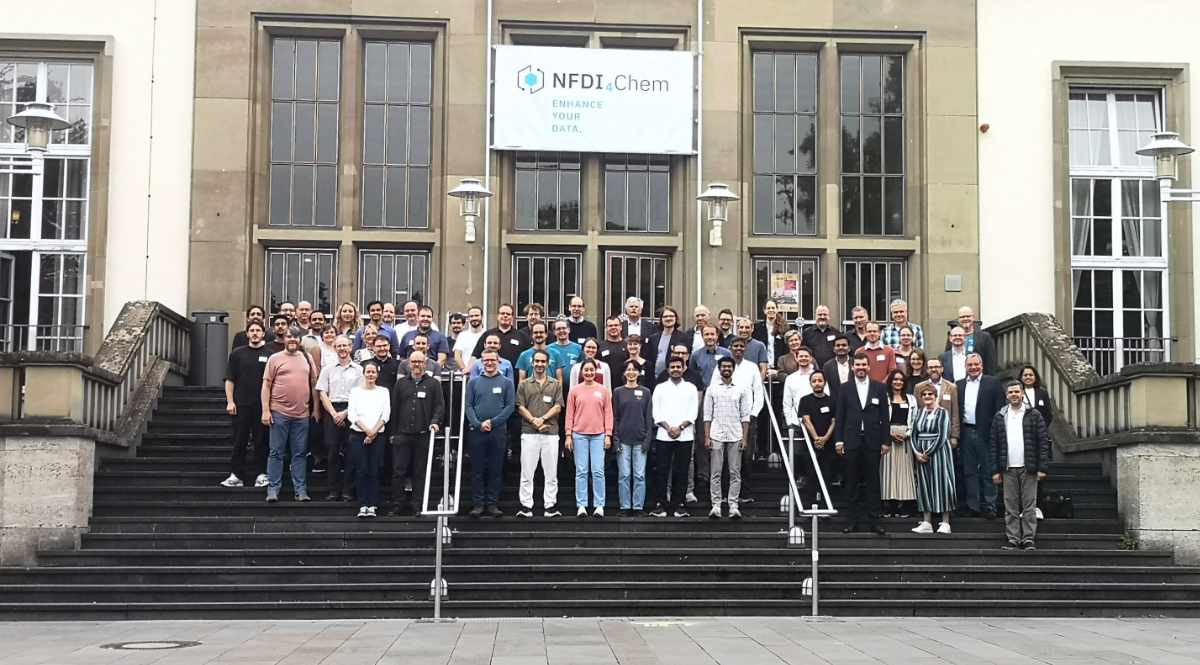(10.–11. September 2025, Mainz)
The sixth NFDI4Chem consortium meeting took place in Mainz with more than 70 participants. The event provided a comprehensive review of the work carried out so far in funding phase 1 and presented key findings from various areas of work.
In their welcome speeches, Christoph Steinbeck and Johannes Liermann emphasised the successes of the first project phase, both in terms of the goals achieved and the close and collegial cooperation between the more than 30 partners.
ELN and repositories
The first day kicked off with a keynote lecture by Simon Bray on Galaxy, a freely accessible internet platform that allows users to analyse and process scientific data without any special prior knowledge. Topics discussed included the integration of different programming languages, new developments in the Python ecosystem, and the integration of commercial tools and community contributions. Galaxy currently offers users access to around 4,000 tools with 250 GB of storage.
The first session dealt with the smart lab environment, focusing on electronic lab notebooks (ELNs), in particular Chemotion. The number of users of this ELN developed at KIT is growing, with around 60% of all NFDI4Chem helpdesk enquiries now relating to this system. New templates, the integration of external applications and data annotation processes were presented. At the same time, emphasis was placed on the importance of repositories in which data can be stored in a FAIR manner. Repositories are therefore essential for achieving our vision of “all chemists publish FAIR data”.
The repository RADAR4Chemcurrently has a FUJI FAIRness score of 92% and offers new features such as reviewer access, AI-assisted metadata creation, GitLab import and advanced download options. Other contributions addressed the integration of nmrXiv, the further development of MassBank with new search and download functions, and the establishment of SupraBank despite staffing shortages.
Another focus was the module (Bio)Chemistry & EnzymeML, which presents new approaches for modular research data infrastructures, as well as the presentation of the FAIR Chemistry Repository.
In the evening, Torsten Schrade (NFDI4Culture) gave an inspiring lecture on the connection between cultural data and chemical structures. Interfaces between 3D representations from cultural studies and chemical data were discussed, including a possible semantic link via InChI or Iconclass. It was particularly impressive how he used current tools to make chemical elements “sing”.
From standards to community engagement
The second day opened with the session on Standards & Synergies. The MIChIs(Minimum Information about a Chemical Investigation), which ensure domain-specific findability and reproducibility, played a central role. Initial standards already exist for NMR, mass spectrometry and UV-VIS, with more in the pipeline. Discussions focused on how the community can be more closely involved in further development, including with the help of AI-supported preliminary drafts.
The Chemical Methods Ontology was presented in terms of interoperability and collaboration with IUPAC and international partners. At the same time, extensions were developed by ChemDCAT-AP and Converter Services, which provide standard formats such as mzML. The concept of a
The session on Community Engagement & Training highlighted activities in the areas of public relations, social media, newsletters, the FAIR4Chem Award and regulars’ tables. The helpdesk has processed over 1,200 enquiries since 2021. The knowledge base primarily contains important information on choosing repositories and ELNs.
The training measures focused on Chemotion-specific workshops, train-the-trainer modules and a chemistry-specific data management template. Particular attention was also paid to the integration of research data management into university teaching, with data and information literacy increasingly being identified as key qualifications.
One practical example was the euroSAMPL benchmark study, which has since been published with NFDI4Chem branding and implements FAIR+R principles (reproducibility).

Sustainable data
A subsequent workshop dealt with ecological aspects of data management. Discussions focused on resource consumption in storage, the role of IT centres and funding organisations, and approaches for greater transparency and versioning. It was proposed that sustainability criteria be integrated into calls for funding.
completion
The meeting concluded with an outlook on future priorities in Phase 2: expansion of standards and ontologies, greater FAIRification through MIChIs, international harmonisation, ensuring sustainable structures and promoting community involvement. In addition, Thomas Hartmann (FIZ) was thanked for his many years of work on the project.
Advisory boards
A meeting of the advisory boards also took place during the conference. With nine representatives from publishing houses, industry, and the national and international scientific community, the NFDI4Chem Steering Committee discussed the work programme for the coming funding phase, as well as long-term strategic decisions that will need to be made in the NFDI in the coming years. Furthermore, possibilities for advancing the cultural shift towards a digital research environment and FAIR data management were discussed. As publishers of scientific literature play a central role in this, NFDI4Chem is organising the next Editors4Chem workshop in-persona next year, which will provide a platform for networking and address the quality assurance of scientific data.